Sustainability isn’t merely a trend—it’s a lifestyle choice that is becoming a priority for many homeowners in Singapore. With an increasing awareness of environmental impact, more individuals are seeking ways to design their homes responsibly, opting for materials and solutions that benefit both the planet and their living spaces.
However, sustainable design isn’t solely about selecting “eco-friendly” materials. It involves making thoughtful, lasting choices that minimise waste, improve air quality, and enhance your home’s durability. Whether you’re renovating an HDB flat, condominium, or landed property, there are practical ways to integrate sustainability into your design without compromising on style or functionality.
Sustainability in Interior Design: A Smarter Way to Build Your Home
A sustainable home isn’t merely defined by the materials—it encompasses the design and utilisation of your space. Rather than concentrating solely on “green” labels, consider aspects such as longevity, efficiency, and health benefits.
Here’s what genuinely contributes to a home’s sustainability:
- Health & Wellness – Materials that improve indoor air quality, like low-VOC paints and low-in-formaldehyde plywood.
- Smart Space Planning – Thoughtful layouts that reduce the need for future renovations.
- Durability Over Trends – Choosing materials that last, so you don’t have to replace them frequently.
- Energy Efficiency – Using LED lighting & energy-saving appliances to cut down electricity use.
- Recycling & Upcycling – Finding creative ways to give pre-loved furniture a second life instead of throwing it away.
A well-designed home isn’t just aesthetic—it’s efficient, long-lasting, and built for the future.
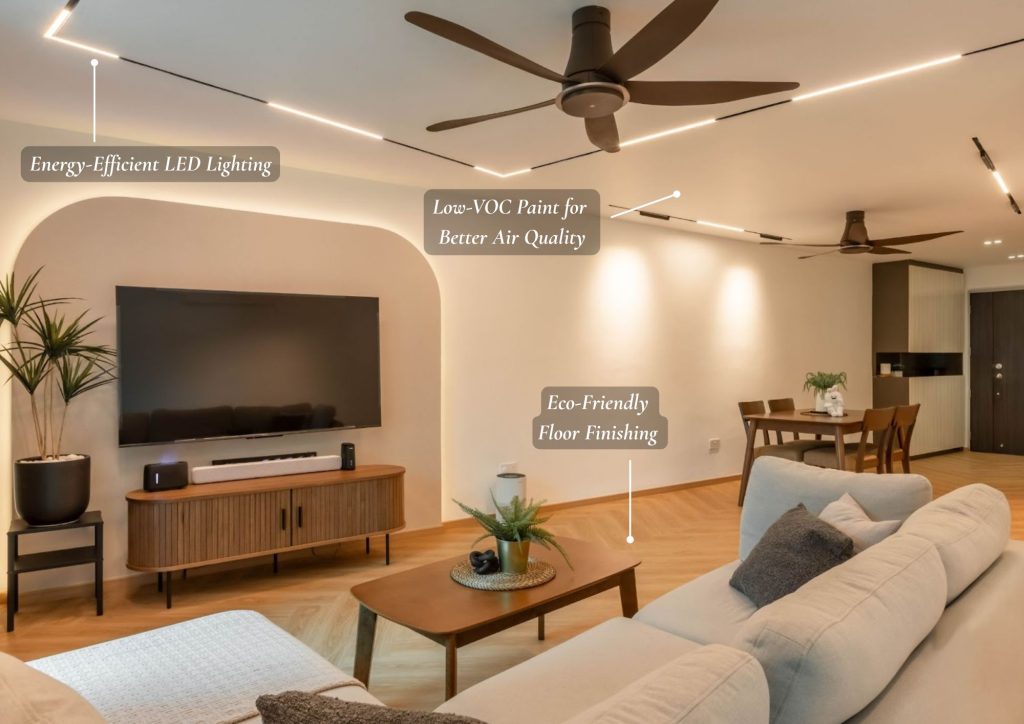
Choosing the Right Materials: Sustainability with Practicality
Not all “eco-friendly” materials are created equal. When selecting materials for your renovation, it is essential to consider their suitability for Singapore’s climate, maintenance requirements, and lifespan.
a) Low-VOC Paints for Healthier Indoor Air
Traditional paints release volatile organic compounds (VOCs), which can cause indoor air pollution and health issues. Low-VOC paints offer the same durability and colour variety, minus the harmful emissions.
Best for: Bedrooms, living rooms, and children’s rooms.
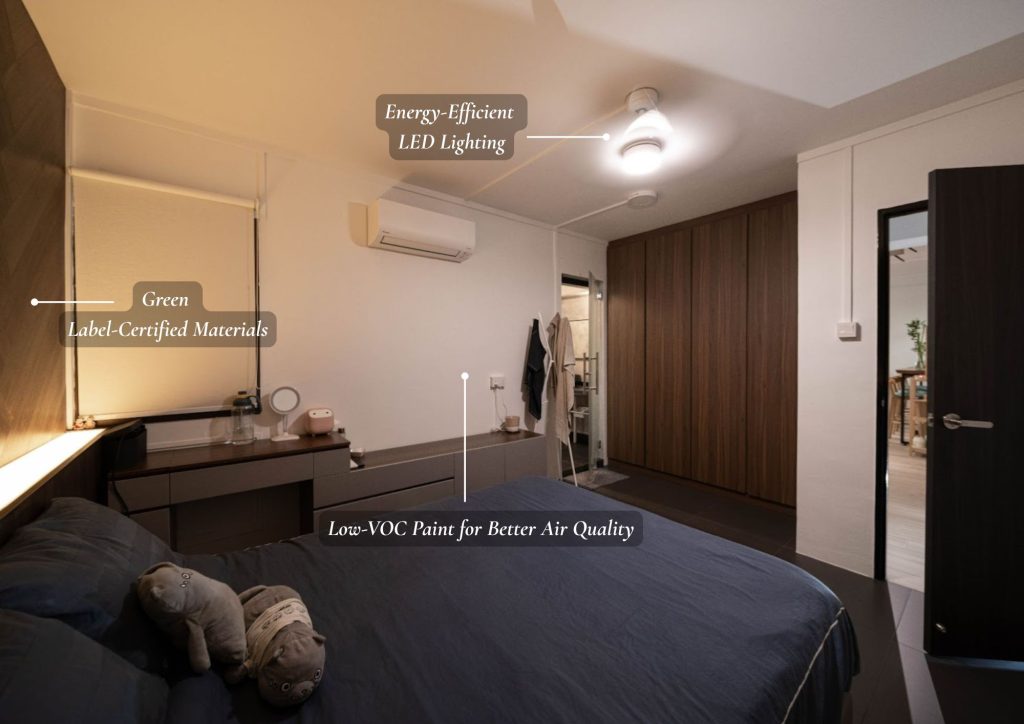
b) Low-in-Formaldehyde Plywood for Safer Built-In Carpentry
Plywood is widely used in kitchen cabinets, wardrobes, and shelves, but regular plywood often contains formaldehyde-based adhesives, which will release chemicals into the air. Opting for low-in-formaldehyde plywood can make your home a healthier space.
Best for: Kitchen cabinetry, feature walls, and wardrobes.
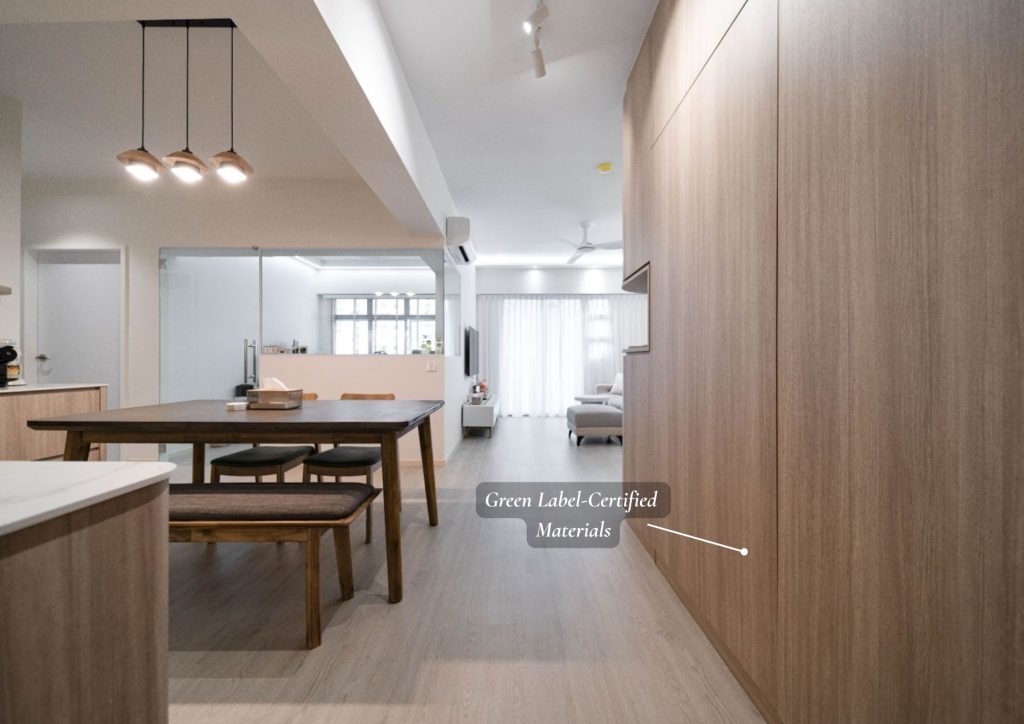
c) Engineered Wood for Flooring & Furniture
For those who love the look of timber, engineered wood offers a practical alternative. It handles humidity better than solid timber, making it a reliable option for Singapore’s climate.
Best for: Flooring, dining tables, and shelving.
d) Quartz Countertops for Long-Term Durability
Quartz countertops are scratch-resistant, non-porous, and easy to maintain, making them a great alternative to materials that require frequent sealing or refinishing.
Best for: Kitchen countertops and bathroom vanities.
e) Green Label-Certified Materials
The Singapore Green Label certifies products that meet environmental standards. Many Green Label products use less energy, water, and raw materials during production, helping to reduce overall carbon emissions. Choosing these products, you contribute to Singapore’s Green Plan 2030!
Best for: Flooring, feature walls, and home finishes.
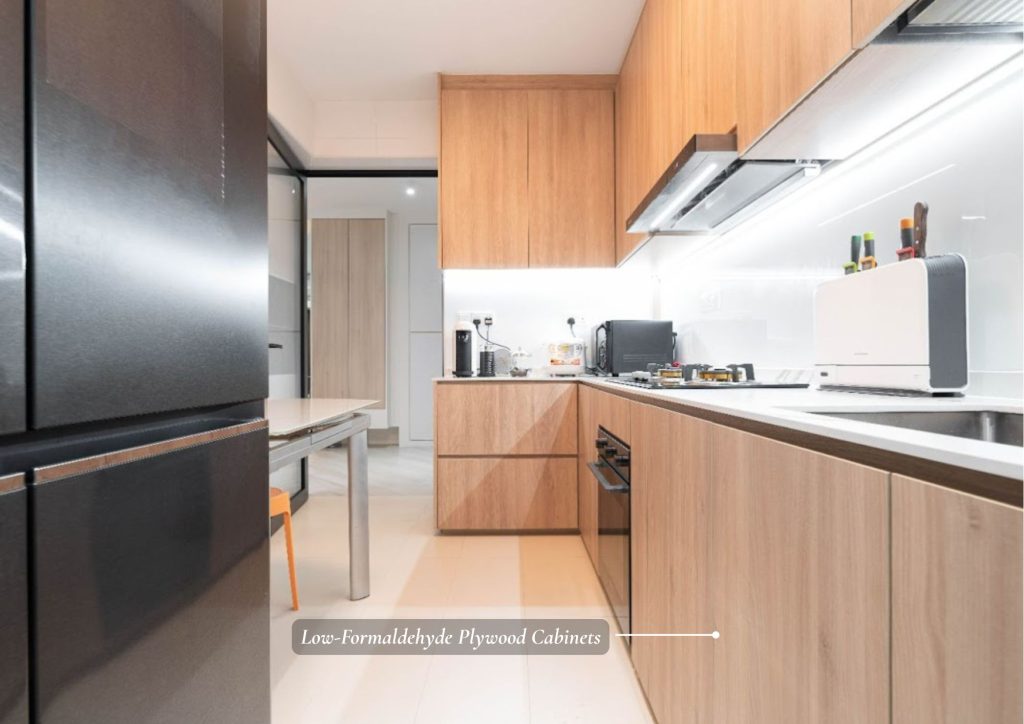
Smart Space Planning: The Key to a Sustainable Home
A well-planned home is a sustainable home. Poor layouts lead to unnecessary renovations, extra furniture, and wasted space—things that can easily be avoided with smart planning.
Ways to Design for Sustainability:
● Choose layouts that last – Instead of following short-term trends, plan for long-term functionality.
● Invest in multi-functional furniture – Extendable tables, sofa beds, and modular shelving allow for flexible use of space.
● Optimise storage – Built-in cabinets reduce clutter and prevent the need for excess furniture.
● Upcycle or Repurpose Furniture – Pre-loved furniture can be refreshed with new upholstery, a coat of low-VOC paint, or creative modifications to suit a modern space.
Sustainability is about being intentional—choosing solutions that work now and in the future.
Energy Efficiency: A Practical Way to Save Costs Sustainably
One of the easiest ways to make a home more sustainable is by improving energy
efficiency. Unlike premium materials, energy-efficient upgrades start saving money
immediately while reducing environmental impact.
a) LED Lighting Over Traditional Bulbs
- Uses 80% less energy and lasts 25 times longer than incandescent bulbs.
- Lower electricity bills without compromising brightness.
b) Energy-Efficient Appliances
- Inverter air conditioners adjust cooling levels to save electricity.
- Smart refrigerators optimise energy use based on usage patterns.
c) Thermal Window Films & Cross Ventilation
- Reduces heat absorption, making it easier to cool your home without heavy air-conditioning use.
- Maximises airflow for better ventilation.
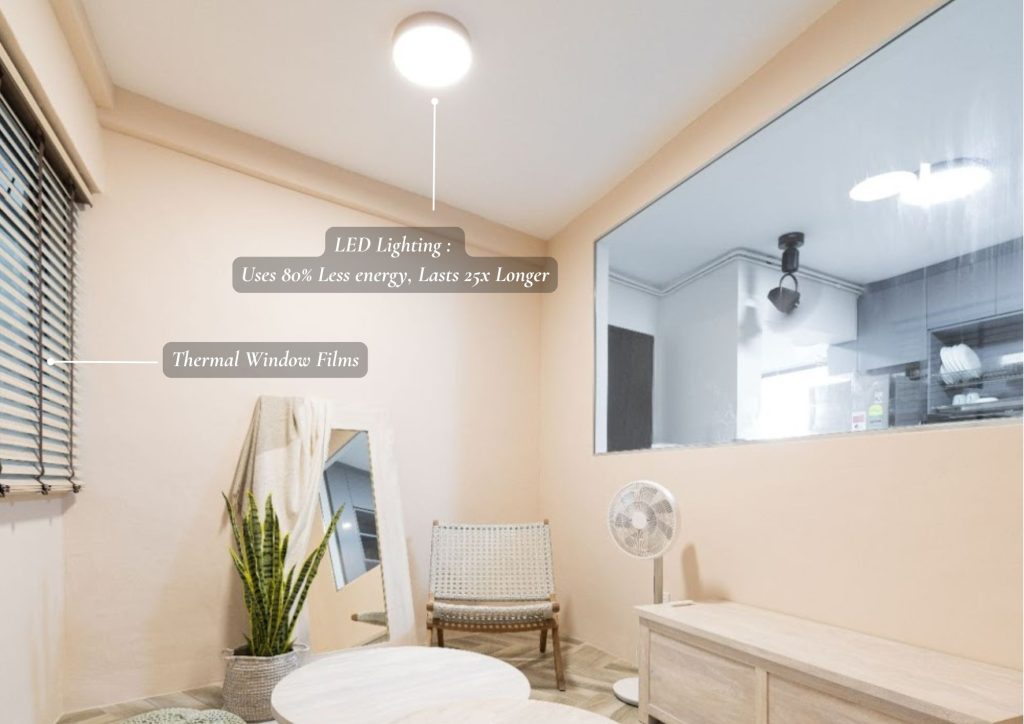
Energy-efficient choices don’t require big upfront investments—they provide instant benefits for your home and wallet.
Sustainability & Your Lifestyle: A Conscious Choice
Sustainability isn’t about finding the “most eco-friendly” materials—it’s about making better choices that last.
Think about what matters to you:
- Is it durability? Choosing materials that don’t need frequent replacements.
- Is it health? Using paints and low-in-formaldehyde plywood that improve air quality.
- Is it energy efficiency? Investing in LED lighting and better ventilation.
By adopting smarter material choices, energy-efficient appliances, and functional layouts, you can create a home that’s both stylish and responsible.
FAQs
1. Why is sustainability important in home renovation?
A well-planned, sustainable home improves indoor air quality, reduces unnecessary waste, and makes living spaces healthier.
2. What are some sustainable materials for Singapore homes?
Low-VOC paints, low-in-formaldehyde plywood, engineered wood, and quartz countertops.
3. How can smart space planning contribute to sustainability?
Efficient layouts, multi-functional furniture, and modular designs help reduce over-renovation and excess furniture waste.
4. Are sustainable homes expensive?
Not necessarily. While some materials have higher upfront costs, energy-efficient lighting and appliances provide long-term savings.
5. How can I make my home more sustainable today?
Start with LED lighting, use low-VOC paints, and consider upcycled or refurbished furniture.
Conclusion
A sustainable home isn’t just about choosing eco-friendly materials—it’s about making practical, responsible choices that work for your lifestyle.
By incorporating:
✔ Durable, healthier materials
✔ Smart space planning to reduce unnecessary renovations
✔ Energy-efficient solutions that lowers electricity usage
…you can create a home that’s better for you and the environment.
If you’re ready to bring sustainability into your home, contact Summer Interiors, a trusted Interior Design Company in Singapore. Let us help you design a beautiful, functional, and environmentally responsible space.










